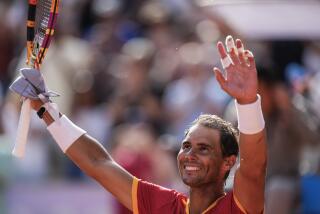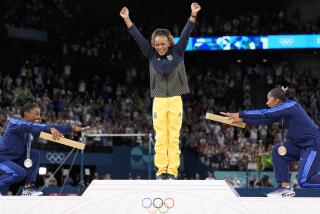The Next Wave of Americans Looks More Like a Wipeout
- Share via
WIMBLEDON, England — Yet another obituary for U.S. tennis has been written over this fortnight, spurred by the dismal performance of the majority of U.S. men and women here, save Pete Sampras.
It is Sampras’ generation of men who set such a high standard and expectations, and that generation is aging, injured or disinterested, depending on whom you’re speaking about.
The group includes Sampras, Michael Chang, Jim Courier, Andre Agassi, Todd Martin and, as far as injuries are concerned, 1996 Wimbledon finalist MaliVai Washington.
Among the women, Monica Seles is not back to her pre-stabbing level and Lindsay Davenport is not up to her own potential. Mary Joe Fernandez, when she’s not ill or injured, is capable of doing what she did here, giving Jana Novotna a tough match. Chanda Rubin hasn’t been the same since her wrist surgery last year.
U.S. players have been bombarded with questions not only about the state of the game at home, but the perceived lack of interest among fans. Interestingly, the players agree that the sport has problems.
“It’s pretty sad, I read somewhere where it’s like 25th in popularity,” Davenport said. “Obviously, it would help if we could have a Tiger Woods-type in American tennis. People aren’t playing the sport in the country and they are not watching it [on television] much, either. Tennis doesn’t seem to be exciting too many fans in the United States. I don’t know what to do to change that.”
Richey Reneberg points to the lack of a next generation among the men and women, the next wave to take over.
“It’s definitely a concern among a lot of American players--there are not a lot of good people coming up through the pipeline,” he said. “The U.S. has always been accustomed to having one good player after another. It seems right now that there is a bit of a drought coming, once Sampras and Agassi finish.
“There isn’t the excitement today. You don’t really have rivalries that Americans can get into. There aren’t rivalries, period. I think that’s the way it’s going to be.”
In a conference call with NBC commentators John McEnroe, Chris Evert and Dick Enberg, the sport was portrayed as being in deep trouble.
In perhaps an inadvertent bit of imagery, McEnroe said he was embarrassed to be associated with tennis, a sentiment many in the sport have held about him for years.
“I’m going to have to agree with this general feeling of malaise in tennis,” McEnroe said. “I do think it’s receding. I do think something needs to be done. I think some drastic changes would be far preferable, but I don’t suspect that will happen.”
Generally, tennis is gaining in popularity around the world, but there are dangerous financial signs that emerged from Wimbledon. Tennis enjoys its biggest popularity in Germany. German television money is, by far, the largest component of the ATP Tour’s television deal. And Mercedes-Benz’s sponsorship is the single largest source of revenue for the men.
What is likely to happen to that sponsorship now that Steffi Graf is out of the game for several months, with an uncertain future, Michael Stich is retired and Boris Becker will no longer play Grand Slam tournaments?
THE SLEAZE FACTOR
Tabloid coverage of Wimbledon can be expected to be mindless and sometimes sleazy. It’s what they do. But this year’s coverage has been remarkable for viciousness and sleaze.
There has been an obsession with female players’ weight, appearance and clothing, while none of that scrutiny has been focused on the men.
Teenagers such as Anna Kournikova and Martina Hingis have had their backsides photographed and displayed more than their faces.
Things got so out of hand that Tony Banks, the British sports minister, finally condemned the coverage, calling it sexist and likening it to “soft porn.”
He urged the media to “concentrate more on women’s tennis abilities rather than their underwear and figures.”
He noted that there wasn’t one story about the “underwear or body shape” of Britain’s top male players, Tim Henman or Greg Rusedski.
“Yet Monica Seles is having her body examined as though she was on an operating table, and references to top players like Martina Hingis and Anna Kournikova are as much about their looks as their tennis.
“This sort of reporting is both sexist and insulting to women. Little wonder so many are put off sports activities and that media coverage of women’s sports seems to concentrate more on sex rather than skills.”
More to Read
Go beyond the scoreboard
Get the latest on L.A.'s teams in the daily Sports Report newsletter.
You may occasionally receive promotional content from the Los Angeles Times.











